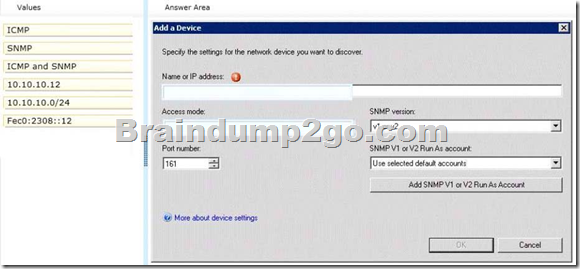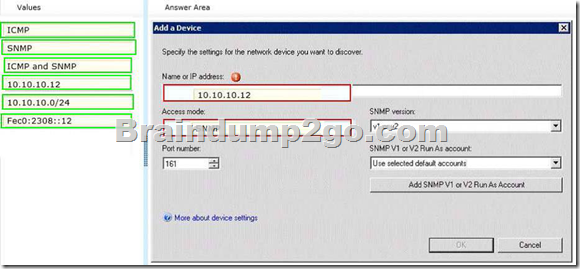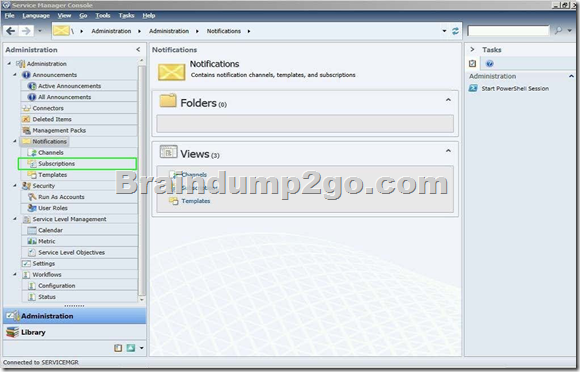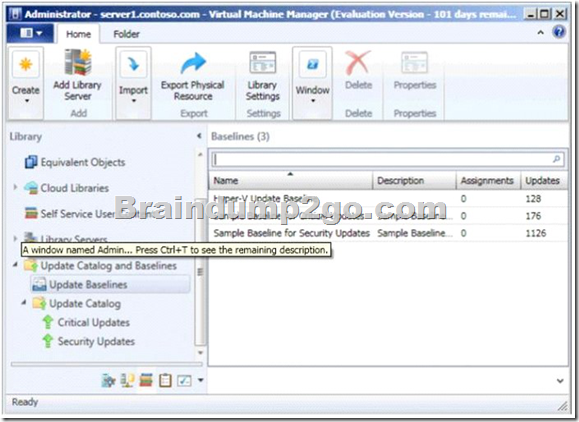New Braindump2go 70-246 Exam Questions Updated Today! Want to know New Questions in 2015 70-246 Exam? Download Free Braindump2go 70-246 Exam Preparation Materials Now!
Vendor: Microsoft
Exam Code: 70-246
Exam Name: Private Cloud Monitoring and Operations with System Center 2012
QUESTION 31
Your company has a private cloud that is managed by using a System Center 2012 infrastructure. You deploy an application visualization solution.
You deploy a server named Server1, and then you install the Remote Desktop Services server role.
Server1 is monitored by using Operations Manager.
You deploy a virtualized application named App1 to Server1.
You need to set the state of Server1 to critical if CPU utilization by App1 exceeds 80 percent for five minutes.
What should you create?
A. a rule
B. a monitor
C. a service level objective (SLO)
D. an event subscription
E. a synthetic transaction
Answer: B
Explanation:
Monitor is the correct answer
Service level Objectives
Service level objectives are measurements to ensure that you are meeting defined service level commitments.
In Operations Manager, you define a service level objective – the set of monitors that you need to track (such as performance or availability) – and then run reports against that service level objective to ensure that you are meeting your goals.
http://technet.microsoft.com/en-us/library/hh212753.aspx
SLO’s are agreed as a means of measuring the performance of the Service Provider.
SLO’s are specific measurable characteristics of the SLA such as availability, throughput, frequency, response time, or quality.
This concept is part of SLM in SCSM 2012.
http://blogs.technet.com/b/privatecloud/archive/2013/03/26/service-manager-2012-and-service-level-management-part-1.aspx
QUESTION STATES:
“You need to set the state of Server1 to critical if CPU utilization by App1 exceeds 80 percent for five minutes.”
SLOs don’t change the state of an object, monitors do:
Create a monitor if…
You want to affect the health of an object.
In addition to generating an alert, a monitor will affect the health state of its target object.
This is displayed in state views and availability reports.
http://technet.microsoft.com/en-us/library/hh457603.aspx
QUESTION 32
Your role of Systems Administrator at ABC.com includes the management of the company’s private cloud.
The company has a System Center 2012 infrastructure that includes System Center 2012 – Service Manager (SCSM).
You use Service Manager for Service Level Management.
You need to create a service level objective (SLO) in Service Manager for incidents that meet the following criteria:
Priority = 1 Incident Category = Email
Problem. Assigned User = Empty.
What should be your first step?
A. You should first create a Service Template.
B. You should first create a Connector.
C. You should first create a Queue.
D. You should first create a Query.
Answer: C
Explanation:
http://blogs.technet.com/b/servicemanager/archive/2012/01/25/scsm-2012-service-level-management.aspx
With queues you can group different work items in Service Manager (SCSM 2010 and SCSM 2012) by criteria. For instance: All Incidents with Priority 2 AND Incident Category „Mail Problem “AND Assigned User is empty.
Queues are used in SCSM 2012 SLA Management to apply the SLA to a group of work items.
SCSM 2012 console -> Library -> Queues”
QUESTION 33
Drag and Drop Questions
Your company has a private cloud that is managed by using a System Center 2012 Operations Manager infrastructure.
The infrastructure contains a management server named Server1.
The network contains two subnets named Subnet1 and Subnet2.
The two subnets are separated by a firewall that prevents ICMP communications.
Server1 is located on Subnet1.
A switch named Switch1 is located on Subnet2.
Switch1 has the following configurations:
– Network ID: 10.10.10.0/24
– IPv4 address: 10.10.10.12
– IPv6 address: fec0:2308::12
You need to discover Switch1.
What should you configure from the Computer and Device Management Wizard? To answer, drag the appropriate values to the correct location in the answer area. (Each value may be used once, more than once, or not at all.)

Answer:

Explanation:
Explicit discovery – An explicit discovery rule will only attempt to discover those devices that you explicitly specify in the wizard by IP address or FQDN.
It will only monitor those devices that it can successfully access.
The rule will attempt to access the device by using ICMP, SNMP, or both depending on the configuration of the rule.
http://technet.microsoft.com/en-us/library/hh212935.aspx
QUESTION 34
Hotspot Questions
Your company help desk uses System Center 2012 Service Manager to manage and track problems.
You need to ensure that the manager of the help desk is notified automatically when a high-priority incident is updated.
What should you configure? To answer, select the appropriate configuration in the answer area.

Answer:

Explanation:
Service Manager uses notification subscriptions to automatically send notifications to selected recipients when a selected condition occurs.
Source: System Center 2012 Service Manager Console
My opinion it would be the Subscriptions menu as it gives access to the ‘Notification Subscription’ wizard.
http://technet.microsoft.com/en-us/library/ff460891.aspx
Before notifications are sent, first configure each notification channel, such as the settings for Simple Mail Transfer Protocol (SMTP). Notification messages are sent based on a notification template. Therefore, you will need to create a notification template.
You can then use the Notification Subscription wizard to subscribe a group of users to a notification that will be sent whenever the changes that you specify occur.
Finally, you can verify that a notification is sent by manually generating the change.
http://technet.microsoft.com/en-us/library/hh524284.aspx
– To create an email notification template and subscription – Step 4:
4.In the Administration pane, click Notifications, and then click Subscriptions.
In the Tasks pane, click Create Subscription, and then complete the Create E-Mail Notification Subscription Wizard.
QUESTION 35
Your company has a datacenter in Los Angeles that contains a private cloud.
The private cloud is managed by using a System Center 2012 Virtual Machine Manager (VMM) infrastructure.
You create a host group named HG1.
You move several Hyper-V hosts to HG1.
You plan to manage Windows updates for the hosts in HG1 by using VMM.
An administrator creates a baseline as shown in the exhibit. (Click the Exhibit button.)

You discover that the updates defined in the baseline are not applied to the hosts in HG1.
You need to ensure that the required updates are deployed to the hosts in HG1.
What should you do?
A. Copy the required updates to the VMM library server.
B. Modify the properties of HG1.
C. Copy the Virtual Machine template to an alternate location.
D. Modify the properties of the baseline.
E. Synchronize the Windows Server Update Services (WSUS) server.
Answer: D
Explanation:
You can see from the exhibit, the baseline the administrator created is not applied.
To apply a baseline, you modify the properties of the baseline to select the hosts and groups.
Source information:
How to Configure Update Baselines in VMM
http://technet.microsoft.com/en-us/library/gg675110.aspx
Assign Computers to a Built-in Update Baseline VMM provides two sample built-in updates baselines that you can use to apply security updates and critical updates to the computers in your VMM environment. Before you can use a baseline, you must assign it to host groups, host clusters, or individual managed computers.
The following procedure explains how to assign computers to the sample security baseline.
To assign computers to a built-in update baseline
1. Open the Library workspace.
2. On the Library pane, expand Update Catalog and Baselines, and then click Update Baselines. The Baselines pane displays the two built-in baselines: Sample Baseline for Security Updates and Sample Baseline for Critical Updates.
3. On the Baselines pane, click Sample Baseline for Security Updates.
4. On the Home page, in the Properties group, click Properties. The Properties dialog box for the Sample Baseline for Security Updates opens.
Note:
On the left of the dialog box, click Updates to open the Updates page.
5. On the Updates page, optionally add or remove update baselines from the baselines that are listed. The Sample Baseline for Security Updates includes all security updates. To ensure that all security updates are remediated, do not remove any baselines.
6. Click Assignment Scope to open the Assignment Scope page and then, select host groups, host clusters, and computers to add to the baseline.
Computers are represented by the roles they perform in VMM. When you select a role, such as VMM server, all the roles that the computer performs in VMM are selected. For example, if your VMM management server is also a library server, selecting your VMM management server under VMM Server causes the same computer under Library Servers to be selected. To apply a baseline to all hosts, select the All Hosts root host group.
7. Click OK to save your changes.
QUESTION 36
Your role of Systems Administrator at ABC.com includes the management of the company’s private cloud.
The private cloud is hosted on an internal System Center 2012 infrastructure.
The network includes servers that run Windows Server 2008 R2 Hyper-V and are managed by servers running System Center 2012 – Virtual Machine Manager (VMM).
You are configuring a hardware profile in VMM.
The hardware profile will be used to create virtual machines configured for Windows Network Load Balancing.
In the Network Adapter Properties, you configure the network adapter to be connected to a logical network and to use a Static IP address from the Static IP Pool.
You now need to configure the MAC address options.
Which two of the following options should you configure? (Choose two).
A. You should select the option for a Dynamic MAC Address.
B. You should select the option for a Static MAC Address.
C. You should tick the Enable Spoofing of MAC Addresses checkbox.
D. You should clear the Enable Spoofing of MAC Addresses checkbox.
Answer: BC
Explanation:
In order for NLB service to function properly, it will assign all clustered NIC the same MAC address. It cannot do this if spoofing is disabled, so answer C is valid. Additionally, we want to make sure that once the MAC addresses are set by NLB, they don’t change, this means answer B is valid.
http://technet.microsoft.com/en-us/library/bb742455.aspx
http://blogs.technet.com/b/jhoward/archive/2009/05/21/new-in-hyper-v-windows-server-2008-r2-part-2-mac-spoofing.aspx (Since VMM is an abstraction to hyperv, we can assume hyperV NLB requirements are the same as VMM NLB requirements.)
QUESTION 37
Your company has a private cloud that is managed by using a System Center 2012 infrastructure. The network contains 50 virtual machines that run Windows 7.
Each virtual machine has an application named Appl.exe installed.
A new version of Appl.exe is released.
You need to identify which virtual machines have the outdated version of App1.exe installed.
What should you do?
A. From Operations Manager, create a monitor.
B. From Configuration Manager, deploy a Desired Configuration Management baseline.
C. From Service Manager, create a Virtual Machine Manager (VMM) connector.
D. From Virtual Machine Manager (VMM), deploy a service template.
Answer: B
Explanation:
Desired configuration management in Configuration Manager 2007 allows you to assess the compliance of computers with regard to a number of configurations, such as whether the correct Microsoft Windows operating system versions are installed and configured appropriately, whether all required applications are installed and configured correctly, whether optional applications are configured appropriately, and whether prohibited applications are installed.
Additionally, you can check for compliance with software updates and security settings.
http://technet.microsoft.com/en-us/library/bb680553.aspx
QUESTION 38
Your company has a private cloud that is managed by using a System Center 2012 infrastructure. You deploy Data Protection Manager (DPM) to a server named DPM1.
A server named Server1 has the Hyper-V server role installed and hosts a virtual machine named VM1.
From DPM1, you perform a full backup of Server1.
You discover that you are unable to restore individual files from VM1.
You need to ensure that you can restore individual files from VM1 by using the DPM Administrator console.
What should you do first?
A. On VM1, install Windows Server Backup.
B. On DPM1, attach the VHD of VM1.
C. On DPM1, install the Hyper-V server role.
D. On VM1, install the integration features.
Answer: C
Explanation:
In either case, DPM utilizes the Hyper-V VSS writer to synchronize block-level differences within the VHDs using a process called an “Express Full”, which identifies which blocks have changed in the entire VHD and then sends just the updated blocks or fragments. This provides a complete and consistent image of the virtual hard disk files on the DPM server or appliance.
DPM maintains up to 512 shadow copies of the full VHD set by storing only the block-level differences between any two images.
http://blogs.technet.com/b/bettertogether/archive/2010/11/16/why-dpm-2010-and-hyper-v-are-better-together.aspx
Credit to computer for finding this one
QUESTION 39
Your company has a private cloud that is managed by using a System Center 2012 infrastructure. The infrastructure contains multiple servers that have Data Protection Manager (DPM) installed. A DPM server named Server1 is running out of hard disk space.
You add additional physical hard disks to Server1.
You verify that the additional disks are available from the local Disk Management console.
You need to ensure that the additional disk space can be used to store DPM backups.
What should you do?
A. From the DPM Administrator console, click Refresh.
B. From the DPM Administrator console, click Disk Allocation.
C. From the DPM Administrator console, click Add.
D. From the DPM Administrator console, click Rescan.
Answer: C
Explanation:
To add disks to the storage pool.
In DPM Administrator Console, on the navigation bar, click Management, and then click the Disks tab. In the Actions pane, click Add.
The Add Disks to Storage Pool dialog box appears.
The Available disks section lists the disks that you can add to the storage pool.
Select one or more disks, click Add, and then click OK. Adding Disks to the Storage Pool
http://technet.microsoft.com/en-us/library/bb808852.aspx
QUESTION 40
Your company has a private cloud that is managed by using a System Center 2012 infrastructure. You deploy Data Protection Manager (DPM) to the private cloud.
You configured DPM to back up the following information on 20 servers that run Windows Server 2008 R2:
– Data volumes
– System state data
– Volume mount points
You discover that the system state backup fails on all of the servers.
You can verify that all other data is backed up successfully.
You need to ensure that the system state backup completes successfully on all of the servers. What should you do?
A. Install Windows Server Backup on each server.
B. Connect each server to a dedicated LUN.
C. Reinstall the DPM agent on each server.
D. Add each server to a dedicated protection group.
Answer: A
Explanation:
A system state backup uses the Windows Server Backup feature to take a snapshot of the system state and saves it locally to the server before moving it to the DPM server storage pool. Troubleshooting Data Protection Manager System State and Bare Metal Backup
http://blogs.technet.com/b/dpm/archive/2011/10/31/troubleshooting-data-protection-manager-system-state-andbare-metal-backup.aspx
Braindump2go New Published Exam Dumps: Microsoft 70-246 Practice Tests Questions, 182 Latest Questions and Answers from Official Exam Centre Guarantee You a 100% Pass! Free Download Instantly!

